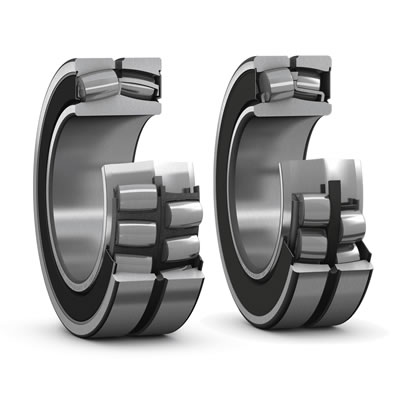Sealed series Spherical Roller Bearings
 Sealed type - Spherical roller bearings
The sealing of spherical roller bearings can be divided into two types: self-sealing and external sealing. The so-called bearing with its own seal is to make the bearing itself into a device with sealing performance. Such as bearings with dust cover, sealing ring, etc. This kind of seal occupies a small space, is convenient to install and disassemble, and the cost is relatively low.
The so-called bearing with external sealing performance means that a sealing device with various performances is manufactured inside the installation end cover. The following 6 main factors should be considered for the selection of external seals for spherical roller bearings.
1. Bearing lubricants and types (grease lubrication and oil lubrication);
2. The working environment of the bearing and the size of the space occupied;
3. Advantages of the shaft supporting structure, allowing angular deviation;
4. The circumferential speed of the sealing surface;
5. The working temperature of the bearing;
6. Manufacturing cost.
The external seal is divided into the non-contact type and contact type.
1) Contact seal
The contact seal is a seal that is in contact with its relative moving parts and has no gap. Due to the direct contact between the seal and the mating part, this kind of seal has relatively high friction during operation and generates a large amount of heat. It is easy to cause poor lubrication, and the contact surface is easy to wear, which causes the sealing effect and performance to decline. Therefore, it is only suitable for medium and low-speed working conditions. Commonly used contact seals are felt seals, cup seals, and other structural forms, which are used on different occasions.
2) Non-contact sealing
The non-contact seal is a seal in which the seal does not contact its relative moving parts and has an appropriate gap. This type of seal produces almost no frictional heat and wear during work, and is especially suitable for high-speed and high-temperature applications. Commonly used non-contact seals are gap type, labyrinth type, and gasket type, and other different structures, which are used on different occasions. The gap of the non-contact seal should be as small as possible.
Sealed type - Spherical roller bearings
The sealing of spherical roller bearings can be divided into two types: self-sealing and external sealing. The so-called bearing with its own seal is to make the bearing itself into a device with sealing performance. Such as bearings with dust cover, sealing ring, etc. This kind of seal occupies a small space, is convenient to install and disassemble, and the cost is relatively low.
The so-called bearing with external sealing performance means that a sealing device with various performances is manufactured inside the installation end cover. The following 6 main factors should be considered for the selection of external seals for spherical roller bearings.
1. Bearing lubricants and types (grease lubrication and oil lubrication);
2. The working environment of the bearing and the size of the space occupied;
3. Advantages of the shaft supporting structure, allowing angular deviation;
4. The circumferential speed of the sealing surface;
5. The working temperature of the bearing;
6. Manufacturing cost.
The external seal is divided into the non-contact type and contact type.
1) Contact seal
The contact seal is a seal that is in contact with its relative moving parts and has no gap. Due to the direct contact between the seal and the mating part, this kind of seal has relatively high friction during operation and generates a large amount of heat. It is easy to cause poor lubrication, and the contact surface is easy to wear, which causes the sealing effect and performance to decline. Therefore, it is only suitable for medium and low-speed working conditions. Commonly used contact seals are felt seals, cup seals, and other structural forms, which are used on different occasions.
2) Non-contact sealing
The non-contact seal is a seal in which the seal does not contact its relative moving parts and has an appropriate gap. This type of seal produces almost no frictional heat and wear during work, and is especially suitable for high-speed and high-temperature applications. Commonly used non-contact seals are gap type, labyrinth type, and gasket type, and other different structures, which are used on different occasions. The gap of the non-contact seal should be as small as possible.

